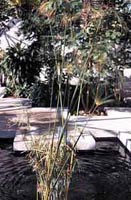Resource Library
Plant of the Week: Papyrus (Bullrush)
The University of Arkansas System Division of Agriculture does not promote, support or recommend plants featured in "Plant of the Week." Please consult your local Extension office for plants suitable for your region.
Plant of the Week
Papyrus, Bullrush
Latin: Cyperus papyrus

Most of us learn what little we know about the ancient cultures of Egypt from Hollywood flicks like "Tomb Raiders" and from the exploits of Indiana Jones. Entertaining but twisted views of Egyptian history emerge from these cinematic efforts. But thanks to our neighbors in Memphis, we now have an opportunity to see first-hand some of the finest Egyptian artifacts held by the British Museum. Among the hundreds of priceless pieces on display are several beautifully preserved examples of papyrus scrolls – ancient road maps known as the Book of the Dead.
Papyrus, or bullrush, (Cyperus papyrus) is a member of the nutsedge family. It’s an aquatic plant that grows along slow-moving streams like the Nile throughout north and central Africa. Plants grow 4-8 feet tall and have dense clumps of thumb-sized stems emerging from a below-ground clump of rhizomes.
The above-ground stems are crowned with an umbrella-shaped inflorescence consisting of up to 100 cylindrical rays that, while technically part of the flower, perform most of the photosynthesis for the plant. The flowers are not ornamental in the classic way, but the plant is very graceful and is commonly used as a tender plant in water gardens.
To the ancient Egyptians, papyrus served the same purpose as pine pulpwood does today. It provided paper. The first papyrus scrolls appear to have been made in the late Old Kingdom about 2500 to 2200 BC. The spells and incantations depicted in the Book of the Dead scrolls were copied from the hieroglyphic symbols carved on the tomb walls of rulers during this period. The scrolls on display in Memphis are from the New Kingdom (1550-1070 BC) and beautifully depict the passage of the soul from a mortal life to the eternal afterlife.
The Book of the Dead was not a "Bible" explaining the beliefs of Ancient Egypt, but a book of prayers intended to serve as a guidebook to help traverse the tricky passage into the afterlife. The scrolls could contain up to 200 spells and be up to 175 feet long.
By the end of the New Kingdom, books were being written in advance with spaces left in appropriate places for the family of the deceased to insert the person’s name.
The most important spells were depicted graphically. Of these, the Weighing of the Heart is the most interesting. In this vignette, the deceased is led into the Hall of Judgment by the god Thoth, the patron saint of scribes. In the presence of Osirus, the god of the afterlife, the deceased’s heart is weighed against that of a feather. In this moment of judgment, those pure of heart pass on, while those whose hears are heavy with sin will have their heart devoured by Ammit, a deity with a crocodile head, a lions front section and the rear section of a hippopotamus.
Paper was made from papyrus stems by first peeling the outer rind and then cutting the inner pith into narrow strips. These still moist strips were then laid side by side in a crisscrossed pattern and then pressed and dried. Paper made using this technique could be of any length desired, but it was expensive by Egyptian standards.
Papyrus is frost-tender, so it must be protected during winter. It can be grown in the water garden in sunny sites or in large decorative pots that are kept on the moist side. Propagation is typically done by division of the clump; but in nature, new plantlets form when the arching stems kink in the middle and the top of the plant is submerged in water. A new plantlet will form from the submerged head and begin to grow. This is one of the few examples where a plant is propagated upside down.
By: Gerald Klingaman, retired
Extension Horticulturist - Ornamentals
Extension News - August 17, 2001
The University of Arkansas System Division of Agriculture does not maintain lists of retail outlets where these plants can be purchased. Please check your local nursery or other retail outlets to ask about the availability of these plants for your growing area.